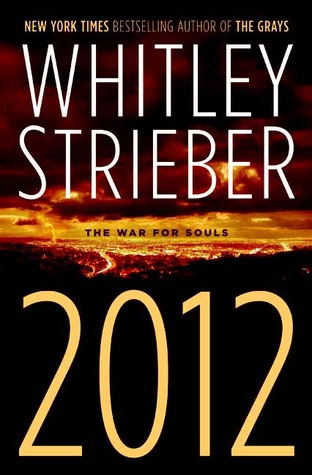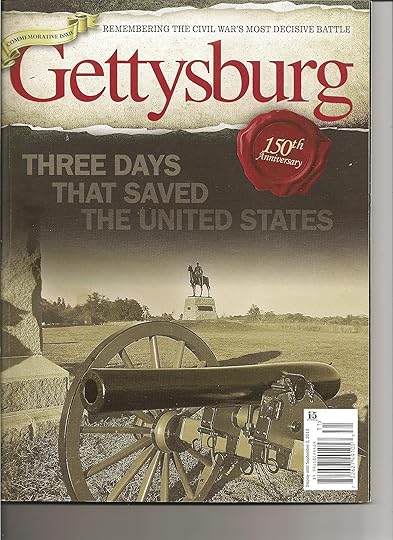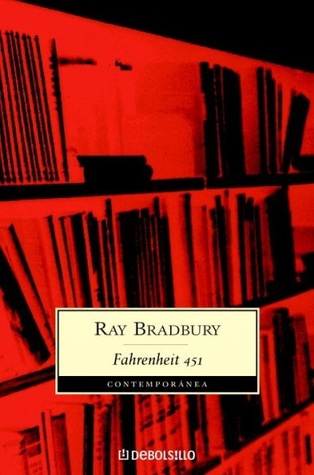Martin Roy Hill's Blog, page 11
June 23, 2013
Strieber's 2012 Thoughtful, Imaginative
 Whitley Strieber is either the most imaginative writer alive or he’s a visionary. Or maybe he just does heavy drugs. Whichever it is, in 2012: The War for Souls, he created a sweeping thriller filled with twists and turns not only in plot, but in science and religion as well.
Whitley Strieber is either the most imaginative writer alive or he’s a visionary. Or maybe he just does heavy drugs. Whichever it is, in 2012: The War for Souls, he created a sweeping thriller filled with twists and turns not only in plot, but in science and religion as well.
As indicated by the title, this book centers on the belief that the ancient Mayans believed the world would end – either figuratively or literally – on December 21, 2012 because a sophisticated calendar created by them ended on that date. But this is no simple doomsday story, like a certain movie with a similar title. Strieber uses the 2012 deadline (no pun intended) to lay bare multiple layers of the human experience. What is the soul? What is reality? What if there was more than one reality? Can a writer be consumed by the world he or she creates in fiction?
Strieber’s plot centers on the concept of multiple universes – or a multi-verse – which many physicists now believe is possible. In our universe, writer Wylie Dale works on a new novel that seems to come to life for him. In a parallel world (this one with two moons) archaeologist Martin Winters fights to save his family and mankind from an invasion of reptilian humanoids from yet a third parallel earth. The reptilians not only intend to take over the two-moon earth, they also intend to extract and imprison the souls of all its humans, which they will sell to the soul-less inhabitants of their own world.
Author Dale is an obvious and often hilarious alter ego of Strieber himself. Like Strieber, Dale has written a book on his experiences as an alien abductee. Dale becomes submerged in his latest work, going into trance-like states in which he writes for hours about the ordeals of Martin and his family. Soon Dale comes to realize that his fictional hero is not a work of fiction, but an actual person living in a parallel version of his own world, and that the Dale and Winters families are somehow connected across the expanses of universes.
Though centered around the Mayan doomsday myth – which obviously did not come about – 2012: The War for Souls, Strieber’s exploration of issues is still valid today. Most of the reptilian world, for instance, is ruled by an oligarchical corporatocracy that has polluted its world and impoverished its inhabitants, a fate that threatens this world where worshiping corporate profits have replaced the worship of Biblical prophets.
2012: The War for Souls is an enjoyable and thoughtful read.
June 9, 2013
Gettysburg: Three Days that Saved the United States
 This July marks the 150th anniversary of the
This July marks the 150th anniversary of theBattle of Gettysburg. The battle holds special significance in the history of
the American Civil War. Not only was it the bloodiest battle of the war,
creating some 51,000 casualties over three days of fighting, it was also what
historians call the turning point of the war.
The fighting that occurred at Gettysburg on July 1-3, 1863
marks the closest the Confederacy got to ending the war, if not with a rebel
victory then with a negotiated peace. Following its defeat at the Pennsylvania
crossroads town, followed one day later by the Union victory at Vicksburg, the
Confederacy was never able to take the offensive again. The civil war would
last nearly two more years, but the die was cast at Gettysburg — the Union
would be preserved.
My latest nonfiction writing project was to contribute a
piece to I-5 Publishing’s recently released commemorative book, Gettysburg: Three Days that Saved the United
States, a pictorial tribute to the soldiers of both sides who fought and
died in that battle.
The high-gloss Gettysburg
takes the reader through those three terrible days of summer, exploring little
known aspects of the fighting. There’s Father Corby, chaplain for the famed
Irish Brigade, who stood amid the bullets and shrapnel to perform a general
absolution. There’s the story of the unknown soldier found dead, a photograph
of his of his children clutched in his hand, and how his identity was finally
determined. And then there’s the story of healing 50 years later when veterans
of both sides of the battle came together for a reunion.
My own contribution is a piece on how Union and Confederate
surgeons treated the terrible wounds created by the new technologies of war.
Gettysburg: Three Days
that Saved the United States is available most major retailers and book
stores.ually remember the titles and the fact I’ve read them. So I didn’t think it bode well for Deep Storm when I started reading it without remembering I had already read it years before. Was it really that forgettable?
No, not forgettable at all. I may not have remembered the title, but I definitely remembered the plot—and it’s a pretty good one.
Dr. Peter Crane is a former U.S. Navy physician with highly respected background in undersea medicine. Therefore, he was not surprised when he was summoned to an oil platform in the North Atlantic to diagnose a strange medical condition spreading through the rig’s crew. Once he arrives, however, Crane discovers the medical condition isn’t affecting the platform’s crew but the crew of a massive underwater facility two miles below the rig. Once sworn to secrecy, Crane is told the submerged facility, called Deep Storm, is excavating an ancient site that may be the remains of the ancient lost civilization Atlantis.
Crane descends to Deep Storm, but as he struggles to discover the source of the strange malady affecting the crew, he begins to suspect there is something far more sinister about the archeological dig than the answer to an ancient myth.
Deep Storm’s plotting is suspenseful and compelling. My only complaint with the book is that Child repeatedly used “sailor,” “Marine,” and “soldier” as if the terms were interchangeable. That’s a real good way to start a bar fight.
May 25, 2013
Review: David Morrell's "Creepers"
 The past plays a major role in many of David Morrell’s novels, and Creepers is no different. A group of creepers – urban explorers who break into old abandoned buildings to document the past – are joined by a reporter as they enter the Paragon Hotel, a once posh hotel that now rots along with many other buildings in Ashbury Park on the Jersey shore. Inside they find secrets – and terrors – that have lain hidden for nearly a hundred years.
The past plays a major role in many of David Morrell’s novels, and Creepers is no different. A group of creepers – urban explorers who break into old abandoned buildings to document the past – are joined by a reporter as they enter the Paragon Hotel, a once posh hotel that now rots along with many other buildings in Ashbury Park on the Jersey shore. Inside they find secrets – and terrors – that have lain hidden for nearly a hundred years.The Paragon itself is a time capsule capturing the history of once popular beach resort of Ashbury Park. Individual rooms stand as memorials to former guests who lived and often died there. But the times gone by of Ashbury Park and the Paragon are not the only histories that concern Morrell. Most of the characters in this novel have pasts they would rather forget, and Morrell explores how those pasts can shape or corrupt the individual.
Three of the characters are victims of one sort of torture or another. One faced torment as a POW during the Iraq war. Another was sexually abused as a child. The third was imprisoned by a psychopathic killer. How those experiences shaped their lives is a major theme of the novel.
Creepers starts slow, but builds to a fast paced, heart-thumping climax.
May 5, 2013
Review: Phillip Kerr's "Prague Fatale"
 Phillip Kerr’s iconoclastic German police detective, Bernie
Phillip Kerr’s iconoclastic German police detective, Bernie
Gunther, returns from the Eastern Front to his Kripo homicide office, wracked
with guilt over what he was forced to do in Belorussia. The last thing he wants
is to spend a holiday in Czechoslovakia with the new Reichsprotector, Reinhard
Heydrich, the boss he fears and hates. But as Gunther says, no one says no to
Heydrich. To make matters worse, Heydrich has invited some of the most heinous
Nazis to his estate to celebrate his new appointment. Nothing could make this
assignment more dreadful—until one of Heydrich’s adjutants is found murdered in
his locked bedroom.
Kerr’s Prague Fatale is a classic locked-door mystery, but
this is no Agatha Christie cozy. To identify the killer, Gunther must peel back
the layers of corruption, greed, and hypocrisy of the Nazi aristocracy. The
mystery’s solution, however, is classic Christie.
Prague Fatale’s
narrative has a straight-forward timeline without the back-and-forth flash
backs of the preceding two Gunther books, If the Dead Not Rise and Field Gray.
This brings it more in line with Kerr’s original Berlin Noir Trilogy. This book
was written about time when debate raged in the United States over so-called “enhanced
interrogation” techniques, and Kerr includes a lengthy and detailed description
of waterboarding. Interestingly, the Nazi didn’t call it torture either.
Prague Fatale is very welcomed addition to the Bernie Gunther series.
April 28, 2013
Anna Pigeon hangs tough in "The Rope"
 Nevada Barr never disappoints. Her Anna Pigeon books do for
Nevada Barr never disappoints. Her Anna Pigeon books do for
the National Park system that Tony Hillerman’s books did for the Navajo
Reservation—create a magnificent sense of place. I do most of my “reading” in
the form of audio books that I listen to on my commute. But Barr is one of the
few authors I will only read the old fashion way, with eyes on pages. I want to
savor every page.
The Rope is a prequel to Barr’s earlier Pigeon books. It
explains how a one-time New York stage manager became a law enforcement ranger
for the U.S. National Park Service. Escaping the Big Apple after the death of
her husband, Anna takes a temporary position as a seasonal ranger. Shortly
after, however, she wakes up to find herself trapped in a deep desert
depression with no clothing and no way out of the “solution hole.” Her only
company is a baby skunk and the half-buried corpse of a young girl.
Rather than solve the crime of her kidnapping and
imprisonment, Anna’s rescue results in more mysterious deaths. Anna Pigeon has
to transform herself from a damaged city girl into an outdoor woman capable of
holding her own against Mother Nature and the men who dominate the law
enforcement ranger force.
As I said, Nevada Barr never disappoints, and The Rope is
another fine installment in the Anna Pigeon series.
April 25, 2013
50 Years Later, Farentheit 451 Still Holds Up
 Everyone seems to know something about Ray Bradbury’s classic dystopian novel, Fahrenheit 451, even if you haven’t read it. In a future America where books are banned and burned by “firemen,” individuals have given up control of their lives to the simple comforts afforded by the mass media. Wall-size television screens – several to a room – provide viewers with simplistic, positive views of the world. The TVs themselves become the individual’s “family,” offering advice and company. Meanwhile, warplanes zoom overhead as the country prepares to start yet another war, a war no one thinks will affect them in anyway.
Everyone seems to know something about Ray Bradbury’s classic dystopian novel, Fahrenheit 451, even if you haven’t read it. In a future America where books are banned and burned by “firemen,” individuals have given up control of their lives to the simple comforts afforded by the mass media. Wall-size television screens – several to a room – provide viewers with simplistic, positive views of the world. The TVs themselves become the individual’s “family,” offering advice and company. Meanwhile, warplanes zoom overhead as the country prepares to start yet another war, a war no one thinks will affect them in anyway.Fireman Guy Montag is a man of two worlds. He enjoys burning books, but he also secretly hordes them. Books make him think, make him question the world he lives in, make him question the wife he still loves even though she has isolated herself from him with a constant droning of government-approved platitudes broadcasted her TVs and radio ear plugs. When Montag’s obsession with contraband literature becomes too great, he finds himself on the other side of the law willing to risk everything to save the books he once was paid to destroy.
Bradbury wrote this book in the early 1950s, not much more than a decade after the Nazis burned hundreds of books, during a time in the United States when McCarthyism turned American against American, and when school boards and churches were banning books from school and public libraries.
In today’s America, large-screen televisions boom with the imbecility of reality TV—who will be the next millionaire, singing star, or Donald Trump’s apprentice. Ten years of war in Iraq and Afghanistan barely touched most Americans. Churches and school boards in Red states are still trying to ban certain books from school and public libraries. The Romans had a term for it: panem et circenses or bread and circuses—creating public approval through diversion.
Bradbury’s, Fahrenheit 451, still holds up a half century after its first printing.
April 22, 2013
Review: Douglas Preston's "Impact"
 An American
An Americanagent hacks his way through the Cambodian jungle, looking for the source of
radioactive gems. In Maine, a college dropout looks for the site where a meteor
crashed to earth. A scientist in California thinks he has made the greatest
discovery in history. In Douglas Preston’s novel, Impact, the three unrelated paths taken by complete strangers come
together in an usual cross between mystery thriller and science fiction.
Writing
alone without his usual partner, Lincoln Childs, Preston lures readers into
believing they’re enjoying a suspenseful mystery, then slowly reveals the story
is actually about an ancient and potentially hostile alien civilization. The
paths of the three strangers come together with explosive bursts of violence,
leaving one dead and the remaining two struggling to save the human race.
Preston’s
narration is simple, direct, and compelling; the story arcs of each character
pull the reader along the way you might lead a kitten with a string toy. The
plot builds to a conundrum, a threat with no solution—until the very last
surprising revelation.
I look
forward to reading more of Douglas Preston’s work.
April 7, 2013
Review: "Woken Furies" by Richard K. Morgan
 If I were a neuroscientist, I’d want to dissect Richard K.
If I were a neuroscientist, I’d want to dissect Richard K.
Morgan’s brain. The 25th century worlds he creates for his Takeshi
Kovacs novels are so richly detailed and colored, his brain must certainly have
extraordinary imaginary powers. This third Kovacs novel, Woken Furies, only strengthens that belief.
Kovacs, a former UN Protectorate Envoy – more enforcer than
diplomat – returns to his native planet, Harlan’s World, seeking revenge on the
Knights of the New Revelation, a cult of misogynist religious zealots he holds responsible for
the death of the only woman he ever loved. In the 25th century,
death is relative. Consciousness has been digitalized and stored in memory
“stacks” implanted in the base of everyone’s skull. As long as the stack
survives, a person can be “re-sleeved” into a new body. If the stack is
destroyed, however, death is permanent. The Knights Kovacs is pursuing made
sure the woman he loved was permanently dead.
Following a raid on a New Revelation strong point, Kovacs
escapes by joining up with a group of “deComs,” mercenaries who earn their keep
by destroying intelligent robotic weapons left over from a civil war that made one
of Harlan’s World’s continents uninhabitable. The group’s leader, Sylvie, is a
“command head” whose brain has been enhanced with electronics to aid in
fighting the robots. Soon it becomes apparent Sylvie’s command software has
been invaded by another consciousness—that of the long dead revolutionary, Quellcrist
Falconer, who begins to take over control of her body.
Kovacs finds himself unwillingly dragged into a
neo-Quellcrist uprising, while at the same time being pursued by New Revelation
assassins, a Yakuza warlord, and agents of the ruling oligarchy, the Harlan
family. Among the latter is an Illegal download of a younger Kovacs
consciousness who determined to kill his older self.
Morgan’s work is known for its acid social commentary, and Woken Furies is drenched in it—from the
oligarchic ruling class to the hypocritical religious extremists. Morgan has said
this would be the last Kovacs book. Perhaps so. But it won’t the last of
Morgan’s work I read.
March 29, 2013
New Mystery Magazine Launched
As if these weren’t enough accomplishments for one person, Darusha has embarked on a new venture, as editor of Plan B Magazine, a new e-zine devoted to mystery and crime short fiction — “cops, con artists, capers and killers,” as the web site says.
Plan B launched in early March with a short story by mystery author Gary Cahill, and will publish a new short story every two weeks until the end of August 2013. At that time, the 13 mystery and suspense stories will be published in an anthology. Among the writers featured will be well-published authors such as Derringer Award-winning writer Nick Andreychuk, Sara M. Chen, Laird Long, and yours truly.
Darusha wants to publish a quality magazine, and since she believes quality fiction deserves to be compensated, Plan B will be a paying market. But readers can enjoy the online stories for free. Of, if you can't wait to read the stories, you can by the e-anthology now at Plan B.

March 22, 2013
New Mystery Magazine Is Launched
 Darusha Wehm is the author of the sci-fi mystery novels Beautiful Red, Self Made, Act of Will, and
Darusha Wehm is the author of the sci-fi mystery novels Beautiful Red, Self Made, Act of Will, andThe Beauty of Our Weapons, writing as
M. Darusha Wehm. Her short fiction has
appeared in publications such as Thaumatrope
Magazine, Luna Station Quarterly,
and Andromeda Spaceways Inflight Magazine.
A Canadian, Darusha is currently living in New Zealand aboard a sailboat in
which she is sailing around the world.
As if these weren’t enough accomplishments for one person,
Darusha has embarked on a new venture, as editor of Plan
B Magazine, a new e-zine devoted to mystery and crime short
fiction — “cops, con artists, capers and killers,” as the web site says.
Plan B launched in
early March with a short story by mystery author Gary Cahill, and will publish
a new short story every two weeks until the end of August 2013. At that time,
the 13 mystery and suspense stories will be published in an anthology. Among
the writers featured will be well-published authors such as Derringer
Award-winning writer Nick Andreychuk, Sara M. Chen, Laird Long, and yours
truly.
Darusha wants to publish a quality magazine, and since she
believes quality fiction deserves to be compensated, Plan B will be a paying market. But readers can enjoy the online
stories for free.



